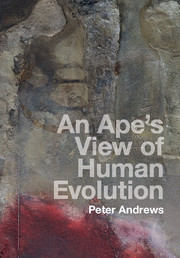Book contents
- Frontmatter
- Contents
- Preface
- 1 How can we recognize common ancestors?
- Part I Apes: their morphology and behaviour
- PART II Environments and palaeoenvironments
- Part III Review of fossil apes
- 7 The view from the early Miocene
- 8 The environment in the early Miocene
- 9 The view from the middle Miocene
- 10 Specialized apes from the middle Miocene
- 11 The environment during the middle Miocene
- 12 A second view from Europe
- 13 The environment in Europe
- 14 Late Miocene to Pleistocene apes
- 15 Apes, hominins and environment in the late Miocene
- Part IV Last common ancestor
- References and further reading
- Index
- References
15 - Apes, hominins and environment in the late Miocene
from Part III - Review of fossil apes
Published online by Cambridge University Press: 05 January 2016
- Frontmatter
- Contents
- Preface
- 1 How can we recognize common ancestors?
- Part I Apes: their morphology and behaviour
- PART II Environments and palaeoenvironments
- Part III Review of fossil apes
- 7 The view from the early Miocene
- 8 The environment in the early Miocene
- 9 The view from the middle Miocene
- 10 Specialized apes from the middle Miocene
- 11 The environment during the middle Miocene
- 12 A second view from Europe
- 13 The environment in Europe
- 14 Late Miocene to Pleistocene apes
- 15 Apes, hominins and environment in the late Miocene
- Part IV Last common ancestor
- References and further reading
- Index
- References
Summary
I am attempting several things in this chapter. In the first place we must consider the environments associated with the fossil apes described in the previous chapter, although for some of them there is little information. I am then going to go straight on to investigate both the morphology and the environment of a group of hominids that have been published as early human ancestors but which have only been mentioned in passing so far in this account. I am making no judgement about whether or not they are on the human lineage, but they are included in this chapter to produce a measure of continuity between them and their fossil ape precursors. They are all important in the tracing of the common ancestor of apes and humans, and the one thing that all can agree on is that they are close to the ape/human common ancestor, either as descendants or as precursors. The only disagreement comes when a decision has to be made as to which side of the common ancestor they fall: on the human or hominin lineage after it has split off from the apes; or on the hominid lineage preceding the split. Before discussing the environments associated with them, it is necessary to consider some of the morphologies present on these fossils, both to show how they were adapted to the environment and to extract characters that may have been important in the common ancestry of apes and humans.
The environment in the late Miocene
The site at Beticha from which Chororapithecus abyssinicus was found occurs relatively late in the Chorora Formation and has a rather different animal fauna from that present in the lower deposits. The sediments formed in a braided river system with palaeosol formation, and the sparse fauna includes a monkey species as well as the fossil ape. There is, however, almost no information on the likely palaeoenvironment present at that time. Similarly, the site at Nakali with fragmentary remains of Nakalipithecus nakayamai has little information on environment. The deposits come from a volcanic mudflow in the upper member of the Nakali Formation, suggesting rapid sediment accumulation. The animal fauna is similar to that of the Samburu Hills site (see below), and it includes several other primate species. It is said to resemble the southern Eurasian faunas linked with evergreen woodland.
- Type
- Chapter
- Information
- An Ape's View of Human Evolution , pp. 219 - 236Publisher: Cambridge University PressPrint publication year: 2016



